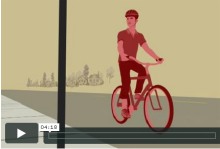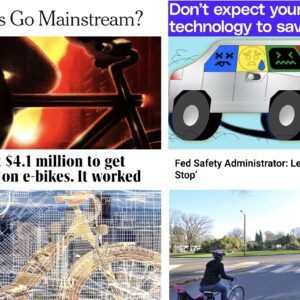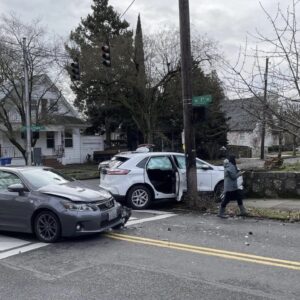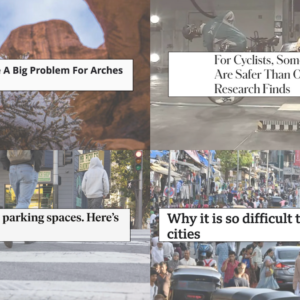
about bikes, stop signs, and the
Idaho Stop Law by Spencer
Boomhower.
Watch it below.
Lots of stop sign news at BikePortland headquarters today.
I spent my morning out at SE Water and Caruthers where city crews recently removed two stop signs that were deemed unnecessary, I just got off the phone with Traffic Division Lieutenant Bryan Parman about an “enforcement mission” (a.k.a. sting) at a stop sign on SE Clinton this morning, and I have been planning an update on the BTA’s Idaho Stop legislation.
Before I get to all those stories, I wanted to share an very cool animation created by Portlander Spencer Boomhower (you might remember him from an article he wrote for BikePortland last month). When he’s not thinking or writing about bikes, Spencer is a freelance computer graphics artist. He masterfully put those skills to use in a video he titled, Bicycles, Rolling Stops, and the Idaho Stop.
Watch it below:
Spencer says he hopes the video makes its way to legislators in Salem who are still pondering the Idaho Stop Law.
…speaking of which… stay tuned for updates on that and all your local stop sign news…





Thanks for reading.
BikePortland has served this community with independent community journalism since 2005. We rely on subscriptions from readers like you to survive. Your financial support is vital in keeping this valuable resource alive and well.
Please subscribe today to strengthen and expand our work.
BeeYooTeeFull. This is what the BTA should have commissioned from day one as PR.
I love it!
Oh, that is so great. So practical.
georgous!
Deftly executed.
So simple even Legislators can understand!
That is the sweetest bicycle animation I’ve ever seen. It blows me away the amount of hard work people are committing to promote bicycling infrastructure.
I hope that animation becomes widely distributed or even viral.
Enforcement mission dollars should be spent where they can do the most good by saving lives. I don’t have the statistics but I am guessing more people are injured and more dollars impacted by speeding cars and drunk drivers than by idaho stops. Enforcement dollars would be best spent outside bars watching for drunks and on freeways watching for speeders.
Watched during my lunch break at work, no sound, but looked VERY COOL!!!
Gonna watch it again tonight!
I love it and seems like common sense. Stopping completely at every stop sign is a pain, especially in low traffic neighborhood, it’s just a big waste of energy. Even more so if you are hauling a trailer and have to get momentum back up from a stop.
My biggest issue riding a bike is cars that roll through stop signs, that scares the hell out of me sometimes. I think the ticket amount should reflect the weight/size of vehicle in use. But that’s a different issue. Rarely do I ever see tickets given to drivers that roll through and well beyond stop signs. You know where they come out not into the car lane completely but it bike path.
This is outstanding work. If the BTA doesn’t snap you up and put you on the payroll to do all their graphic/pr/explanation projects, they’d be missing the boat. Go shop this around to national organizations to get more bike advocacy work and to state groups considering idaho stop legislation.
Again, top flight work.
Spencer-
While I am not for the law, I applaud your work and effort. That was a beautiful piece; pure art.
Thank you for sharing your insight and creativity.
Do you have any other pieces hidden away on a website?
Great, great video, Spencer. The BTA definitely needs to use this in its public relations campaign for the Idaho Stop law. At the very least, the Oregonian should show it to all the readers it has caused to think that the Idaho Stop bill means cyclists will take over the road and sieze the right of way at all times.
Fantastic! I love DJ Hurricane’s comment. Let’s get this to the Legislature immediately. Maybe the Oregonian and KATU could run stories about it too…ok, now I know I’m getting a little carried away.
Very professional, very beautiful.
But there are circumstances, like crossing a high-speed four-lane arterial that does not stop, where a cyclist does not have enough time to scope all vehicles from both directions, even from a full stop.
I’m thinking about SE Foster, where all side streets enter at diagonals. PDOT wisely has built crossing zones, some with central islands, some even with signals. Although these primarily are for pedestrians, cyclists are foolish not avail themselves of such improved protection. Almost all motorists honor the right-of-way for pedestrians and for cyclists too. Good for PDOT!
On the other hand, I am all for nailing idiots who blow through 26th and Clinton at $360 a pop. $10,000 an hour there, easy!
Meanwhile, I’m still perfecting my “traffic stand.”
A May Zing.
Nice work. I especially like the examples given for different intersections/situations and the clarification that this law would not allow us to recklessly zoom through intersections. Nice clear explanation to quell some major concerns about the proposed law.
Thanks Spencer!
Bravo!
Living in Idaho I just assumed that our way was the law everywhere. Watching Oregon cyclist fight to get this law passed has really been an eye opener. I had better be careful when I come to ride the Oregon coast.
Easy to follow and clear from the first second. Very good artwork. (There’s something so friendly about that guitar, also…)
A fine job.
Very well done. The presentation hits on all levels and is easily understood by the daily commuter as well as someone who has never ridden a bicycle, the pedestrian and auto driver.
Excellent! Outstanding! Thanks!
Still don’t get the obsession with not stopping… still don’t get what the huge problem is with current law…
Bravo!
Kracken, you’re welcome to still stop at every stop sign. Nothing in the law says you must roll at a yield.
Holy moly, thanks everyone for the positive response for the video. Getting a positive reception, especially from a group that I know doesn’t pull its punches with the criticism (and I say this having myself been a criticizer of one or two things in these very forums) is incredibly heartening.
I hope it adds to the conversation, and helps BTA’s efforts in Salem.
Thanks to Karl Rohde for expressing enthusiasm for the animation idea early on, and giving me some tips for how best to support the BTA’s mission and message. The feedback from his email list of interested parties really strengthened the message. Thanks also to Scott Bricker and Michelle Poyourow at the BTA for keeping the enthusiasm going, even after Karl left. Also the feedback and props I got from fellow BikePortland contributors was a real boost. Pet projects like this have a nasty habit of fizzling out before they reach the finish line, so the input from all these folks was vital.
#9 K’Tesh:
Yes, please do, the narration is pretty important. Someone suggested it should have subtitles, but there was no time.
#21 kracken41
I don’t know if I’d call it an obsession… Anyway, let me explain: The average bicycle rider gets around on only a hundred watts of propulsion power…
Wait, let me put it another way: I would say most bike riders ride with immense respect for the spirit of traffic law. They are mindful of safety, and the rights of others. They would not do a rolling stop unless they could first be sure the way was clear, and they had the right of way. I.E., not unless they had first met the requirements of the spirit of the stop sign law. They have respect for what the law is trying to accomplish: safety and equity on the road.
They only do this rolling stop thing because it’s efficient, and they need efficiency if they’re going to use their bike as a practical form of transportation (as opposed to, say, a form of exercise, or entertainment).
Despite respecting the spirit of the law, the rolling stop does not adhere to the letter of the law, which makes these safety-minded and respectful citizens who get around via this incredibly healthy and environmentally friendly means of transportation OUTLAWS. Outlaws subject to the same steep fines slapped on far more dangerous vehicles, or on bike riders who don’t give due consideration to their fellow road users.
And you know what, for all my boosting of this law, I think there’s a place for outlaws, that they perform the vital service of always pushing the boundaries of societal constraints, seeing if those restraints really need to be there. Of course, hurting others is beyond the pale. And I get it, a biker blowing a stop, scaring you, and taking your right of way is infuriating; I’ve been on the receiving end of this behavior, just like most of us have.
However, the safety-minded bike rider who safely rolls a stop to keep his or her bike an efficient enough means of transportation? That’s not an outlaw. Or shouldn’t be, anyway.
Branding a person a criminal when it shouldn’t ougta be that way is an injustice. In this case it’s only a teeny-tiny injustice, really, but even a little injustice is galling, and that erodes the usefulness of laws.
If you KNOW you’re riding in a way that’s safe and respectful, but you’re looking at a $242 ticket you just got slapped with in a sting, you lose respect for law. Doesn’t it seem like a problem if safety-minded, conscientious people lose respect for the law?
I think maybe it didn’t use to be a problem because there were so few people riding bikes. But now there’s lots more, and this heretofore overlooked bending of the rules is no longer being allowed to bend. Thus the stings, and thus the people feeling like the law is treating them unfairly.
This can and should be sorted out. We should always be trying to make our laws more fair, and the great thing about a democratic society is that it’s designed for this. It’s designed for the laws to adjust such that they correct inequities, and to allow for changing conditions (which is why car drivers are no longer required to turn off their engines at every stop sign).
Right here, right now, in Oregon, we’re in the midst of conditions changing in a big way when it comes to bikes on public streets. We have the opportunity to adjust to these changes in a way that makes sense.
Anyway, I could go on and on. And I do (obviously).
Brilliant. If metal cowboy doesn’t snap you up and put you on his payroll to show our elected officials what’s wrong with a 12 lane CRC bridge, he’d be missing the boat.
What payroll? 😉 But I will be talking to Spencer about how he might be able to help the CRC effort. In exchange I’d make introductions to national and state ped and bike organizations who could use his talents and do have budgets.
I’m already off and running with a CRC project :). I actually put it aside to work on this, because this seemed more time-critical. But I’m even getting help on the CRC project from a fellow CG guy who’s also interested in this stuff.
Which reminds me, I forgot to answer:
Mike #12
I do, but this is the first thing of its kind that I’ve done. The rest has been mostly for games – and nothing even slightly bike related :). So it’s probably not what you’re looking for. Thanks for the interest, though, and keep an eye out for more stuff like this. It was a pretty satisfying project.
Lets get this on real TV!
This is great, Spencer!!! I was thinking the Idaho Stop bill was a long shot until I saw this.
BP readers, please forward, blog, and FB the video to every one you know.
I love the animation and I hope the law passes, but if it doesn’t…there is another viable solution to this volatile issue.
Yield signs allow a person (no matter the means of transport) to get through without wasting time/energy on a complete stop. In practice however, this means that cars still need to make a complete stop, due to their obstructed vision and longer stopping distance. While a cyclist can look both ways and keep going.
Why do we choose frivolous stop signs and dangerous uncontrolled intersection instead of a simple, logical, YIELD?
Ditto what Dan and others have said.
Regarding Facebooking the video. Is it part of the Facebook Idaho Stop Law Group? If not it should be.
Excellent work, Spencer. I look forward to seeing what you produce regarding CRC. Can you make that guy on the bike look like the Metal Cowboy?
Hey Dan #29, thanks a bunch for the pro advice along the way, and I’m looking forward to any input you can offer future revs.
Scott #31 I’m embarrassed to admit I didn’t even know there was a FB group. Now joined, with a first post saying: “how do I embed a video here?” I’ll throw that same question out here, because I’m hesitant to experiment with someone’s FB group page.
This would be GREAT in OREGON!
casey 30 is onto something here. if we do not have the political clout to get a rolling stop law passed at the state level, we may nonetheless have the clout on a much lower level to get rid of badly placed stop signs. let’s pick them off one by one. what’s the skinny on southeast water and caruthers? who said what to whom to make this happen?
oh, and excellent video. tiny quibble, where you say a cyclist blowing through a stop in idaho would be fined $x, higher than currently (in oregon), you should say “in oregon.”
Another ‘well done’ from me to Spencer. I love how you illustrated how this law would work at different kinds of intersections.
fantastic! The discussion of this legislation has been fraught throughoutwith misunderstanding, and this should help in a major way.
From the MUTCD (Manual of Uniform Traffic Control Devices, the traffic engineer’s bible)definition of what a Yield sign mean:
“Vehicles controlled by a YIELD sign need to slow down or stop when necessary to avoid interfering with conflicting traffic.”
Slow down, and stop when necessary. Simple.
They threw this up on the PGH blog, urbanvelo.org this morning.
Good work.
fantastic animation!
i’d be curious to see what it would have been like if we squeezed in something a bit more explicit about cars’ ability to murder people, but not bikes, but i love the video.
Regarding the comments on yield signs, stop signs are the sacred cow of lazy traffic calming (in Minneapolis at least). I would bet you’d have a tougher time changing stop signs to yields than you would getting an Idaho Law passed at the state level.
#35 are
That’s a good suggestion. I get into the habit of calling it the Idaho Stop on the assumtion that everyone knows what I’m talking about, but I could see how it would be worth pointing out that it’s an Oregon law more frequently.
#36 Yokota
Thanks, and I appreciate the post on your blog!
#37 bikieboy
Thanks much, and you’re right, it really needs to be driven home to people: JUST. LIKE. A. YIELD. Everybody knows how a yield signs works, right? (Though to be fair, I can’t think of anyplace where there’s a 4-way intersection where one sign is a yield and the other 3 are stops. That could be tripping people up.) In the demonstration section, I wanted to keep up the thought-bubble-with-the-yield-sign-over-stop-sign motif, but eh… Time constraints.
#38 Amos
Thanks, and thanks also for the pointer to the blog.
#39 Peter
Much appreciated, and I did want to include the relative danger of cars, in some symbolic means akin to the 1000 lightbulbs to 1 lightbulb. (40,000 coffins for the 40k + who die per year?) But remember this was primarily intended to go in front of legislators. And one piece of advice I got was that pointing out the destructive power of cars would read as car-bashing, and might not play well to that particular audience. Which on one hand is baffling, but on the other hand makes sense, but on… let’s say a third hand, pointing out the extreme *lack* of danger bikes pose to other road users without also pointing out the relative extreme danger posed by cars seems like it would be ineffective.
And safety is the primary goal of stop sign law in the first place.
#40 Matty
Agreed. And that’s another point I didn’t have time to make well: with all the stop signs on quiet side streets – put there, as you say, for traffic calming purposes – and with the unlikelihood of the signs ever coming down, bike riders who really want to get somewhere – who are using their bikes as transportation – are motivated to use the busier arterial routes.
See: “Why Bicyclists Hate Stop Signs”
http://www.sfbike.org/download/bike_law/why_bikes_hate_stops.pdf
An excellent video however I’m surprised Spencer, you didn’t quote the study (I can’t find the source) that revealed that the energy lost stopping a bicycle from 12mph is enough to propel the bicyclist over 300 feet. When quantified in this way people begin to understand why bicyclist don’t want to stop. Stopping at 20 stop signs consumes enough energy to ride a bicycle over a mile!
Ahhh… There’s that report (directly above my first post, go figure). I thought the report was done at UC Berkley.
Still I’m surprised you didn’t use that example.
And yes, people in New Jersey will see your video (I have means).
That’s a really good way of framing it, and even though I read the paper, I somehow missed that. All the wattage stuff came from that source, though.
Well, I’m still compiling ideas for a revision if it comes to that, and complete stop = 300 feet might make for a good visual.
Your right! It’s not in there. I was sure that it was. I did come across an article from The Times (UK) that mentions this tidbit (http://tinyurl.com/b58ehl).
Still, this should be easy to test. Just ride a bike at 12mph on level ground (do you have any of that in PDX?), let it coast and see how far you go. 300 feet seems about right to me.
pretty sure it would be more than 300
Spencer,
You do outstanding video. I someone will find a way to support you to work on some short defensive/safe riding videos based on the Street Smarts guide that Rodale published. There are so many people who won’t read but who would probably watch video. Best of luck with the Idaho Stop Bill, and in general.
Great production quality, but typical bike utopia approach the problem. Stop signs are necessary to control the portion of society that otherwise would exercise horrible judgment at intersections. That statement applies equally to drivers and cyclists.
It’s laughable that the cornerstone of the cyclist Stop Law argument is energy efficiency for the rider. You should read up on an invention called THE INTERNAL COMBUSTION ENGINE if you are lacking horsepower.
#48 John T:
Thanks!
oh…
I appreciate the even-handedness, but I have to disagree. For a number of reasons:
For one, I’m sitting in a neighborhood surrounded by those peculiar intersections I’ve only ever seen in the Northwest: four-way with NO signs. No stops, no yields. And they actually work pretty well. The only hitch is that some intersections further down the street just got stop signs, which sends more short-cutters down our street. But still, these intersections remain (knock on wood) incident-free.
Also, it’s worth pointing out that the whole rolling stop thing is pretty much how most bike riders get around already. The law would simply decriminalize this common, SAFE practice. And I mean safe: this year we had the fewest bicycle deaths since they’ve been keeping records! (I’m pretty sure it was zero deaths, but I forget exactly.)
Finally, there’s really no need to speculate how this law might work, because it’s already working. In Idaho, where it’s been working great for 27 years, since 1982. (That’s the year Thriller came out! And I really wanted to get a Michael Jackson reference in there but, alas it was another thing cut for time.)
There have even been law enforcement professionals from Idaho coming to Oregon to say: yup, it works fine. Has been for years.
In a time of looming global warming, peak oil, and economic crisis, efficiency is laughable? Again, I have to disagree. Personally I’m very interested in efficiency.
I wanted to get this set of facts into the video, and might still in a future rev:
Found here: http://www.worldwatch.org/node/4057
That’s an AMAZING disparity in efficiency. Bikes are 3 times more efficient than walking!
Talk about inefficient. But I have an internal combustion engine, and I occasionally take it out for a spin. And whenever I do, I think how bizarre it is that I’m having this thing haul around its own several hundred pounds of weight along with another two thousand pounds or so of metal and plastic, just to get me from point A to point B.
It makes me glad I’ve figured out a way and place to live in which the vast majority of the time it’s easier and more enjoyable to just take my bike. (As long as I’m rolling stops though, because there’s a ton of them between me and stores and banks and whatnot.)
Also, it makes me reflect on how insane it is to be using our rapidly dwindling stockpile of available oil – this amazing substance that represents who knows how many thousands of years worth of solar energy harnessed and concentrated into this remarkably stable and portable form – for doing trivial things like running errands and getting to work.
As finite resources go, oil seems meant for better things.
Andy B #45:
Great article, thanks! These are some good points:
And I like this phrasing:
Andy B again:
We’ve got plenty of level ground. Now all I need is a speedometer… But it does sound about right to me.